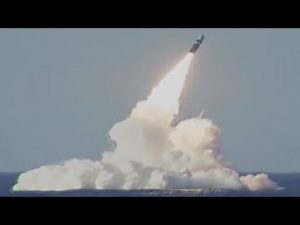
By Ahyousha Khan
To make nuclear deterrence work without any hurdles, states desire invincibility for their nuclear arsenals against the threat of being taken out in first attack massive retaliation from the enemy. Enemy’s lack of ability to wage an aggression is the role assigned to nuclear deterrence. If nuclear arms race between two nuclear belligerents goes on, states strive to keep their deterrence against each other relevant by choosing an option of second strike capability.
Second strike capability allows the state to respond to the nuclear attacker with nuclear retaliation. End of the 20th century was marked with nuclearization of two South Asian neighbors. Ever since their nuclearization both India & Pakistan – are constantly involved in the nuclear arms race. In this contagious race, both have been pulled into the spiral of developing weapon capabilities in the form of ballistic missiles, cruise missiles and ballistic missile defenses to Multiple Independently Re-entry Targetable vehicles. However, recent developments of nuclear submarines and naval nuclear weapons by India and Pakistan are the step forward on the deterrence ladder. Now, both countries are developing their 2nd strike capabilities to deter their enemy form resorting to the first attack.
Since the beginning of its nuclear program, India wanted to have nuclear triad and started its nuclear submarine program in 1970’s. India acquired its first ballistic missile submarine (SSBN) in 2009 and now it is developing its indigenous ballistic missile submarines and nuclear-powered attack submarines (SSN) as well. Moreover, it has sea-based K4, K15, Brahmos and Dhanush missiles. From India’s perspective, the development of 2nd strike capability is a logical step, but it has changed the strategic equilibrium between India and Pakistan. Moreover, it has opened the new arena of nuclear arms race for South Asian nuclear rivals.
However, what is done is done. So, there is no point in repeating these chronological events. But, what is necessary now is the development of credible and survivable 2nd strike capability by Pakistan to maintain the strategic balance and to uphold the nuclear deterrence in the region. This initiative should be important for Pakistan because it is neighbor to ambitious, shrewd, and hostile nuclear neighbor that wants the Indian Ocean as only its area of influence.
At the moment Pakistan does possess 2nd strike capability in the form of BABUR 3 that is nuclear tipped naval cruise missile to deter the enemy. But, what is necessary is the induction of credibility in 2nd strike capability of Pakistan. The reason behind why Pakistan never opted for nuclear triad earlier is its firm belief in the idea of credible minimum deterrence.
But, with India’s massive nuclearization and naval buildup, Pakistan cannot sit in denial and needs to develop its 2nd strike capability. It is important for Pakistan to develop 2nd strike capability more than ever because, with a huge investment in CPEC and Gwadar Port, Pakistan wants to claim its piece in the Indian Ocean Region for its economic development as well. Development of credible 2nd strike capability would enable Pakistan to protect and promote its interest in the Indian Ocean Region where Indian naval vessels patrol throughout the year. Therefore, for economic prosperity, security of SLOC and ports is necessary so that enemy is not able to use these economic centers as leverage in case of a crisis.
Thus, Pakistan needs to take many initiatives for enhancing its second strike capability. First and foremost initiative should be an investment in the development of small but high-tech shipbuilding industry for achieving self-sufficiency. No country in history has achieved the status of global power with borrowed vessels and purchased ships.
Moreover, Pakistan needs to invest in nuclear powered ballistic missile submarine as well. Because so far Pakistan has spent only in diesel-electric submarines (SSK) that use air-propulsion. For the credibility of sea-based deterrence, it is necessary that its position remains hidden from the enemy. Nuclear powered submarines can stay submerged for longer duration that provides them with the better opportunity to hide from enemies radars. Another aspect that will affect the future of Pakistan’s SSKs is Indian space modernization. With the ability to see from space, India could locate submarines that have to reemerge after every three weeks. Moreover, with SSKs Pakistan is only enable to deploy its cruise missiles and on SSBN Pakistan could deploy its strategic weapons as well.
Lastly, to avoid any accident, both countries need to develop some CBMs on practicing restraint, reporting nuclear accidents and advance notification of missile testing. These initiatives are important because with the development of 2nd strike capability and naval nuclearization both parties are venturing into untapped territories of nuclear competition.
